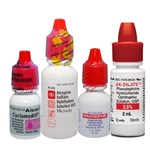Your eye doctor will put a small amount of dilating eye drops into each of your eyes (called mydriatics) so that your eye doctor can see the inside of your eye in detail, including the entire retina, the part of the retina called the macula, and the optic nerve. There are two main types of drops. One type causes special muscles of the iris to contract, which makes the pupil bigger (dilation). The other type prevents special muscles from making the pupil smaller, and also relaxes the eye’s ability to focus (cycloplegia). The two kinds of drops are usually used together, either as two separate drops, as a single combination drop, or as a spray. All these changes are temporary, and usually last for a short amount of time. It usually takes about 20 to 30 minutes for your pupils to fully open. Light-colored eyes (such as blue, green or hazel) will dilate faster than brown eyes.
The eye drops used for dilation cause your pupils to widen, allowing in more light and giving your doctor a better view of the back of your eye. Eye dilation assists your doctor in diagnosing common diseases and conditions, possibly at their earliest stages. They include:
- Diabetic retinopathy
- High blood pressure
- Age-related macular degeneration
- Retinal detachment
- Glaucoma
- Cataracts
During a dilated exam, your doctor can spot problems like a torn or detached retina or an eye tumor also.
Dilation drops last anywhere between 6 and 24 hours, depending on the drop used. Blue eyes are more sensitive than brown and can stay dilated for longer periods of time. Many patients are concerned about the potential side-effects of these drops. The reality is that these drops are relatively well tolerated. Most patients experience some light sensitivity and blurry near vision. Dilation doesn’t typically affect your distance vision. But because your pupils can’t control the amount of light going into your eyes, the glare outside may bother you. For some people, that makes it unsafe to drive. So make arrangements to have a driver when having a comprehensive eye exam.
#eyegotcha
Sources:

